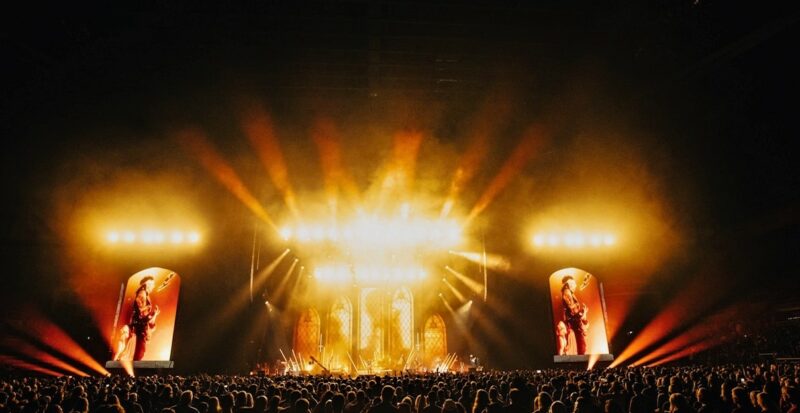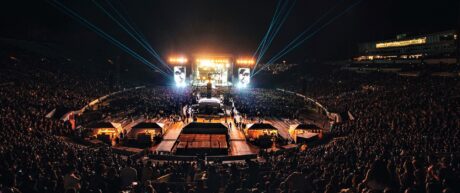
Each band has sold over 100 million albums. One has been inducted into the Rock and Roll Hall of Fame. The other has its own star on the Hollywood Walk of Fame. Collectively, their wildly intense sound and explosive stage presence have left an indelible mark on metal music. Reflecting the fiercely independent personalities of Mötley Crüe and Def Leppard in light on a co-headline tour requires a deftly balanced show, one that celebrates each legend’s journey. A towering, power-projecting, cathedral-like design by Mike Cooper that featured CHAUVET Professional STRIKE Array 4 blinders and Color STRIKE M motorized strobes did that in brilliant fashion, supporting the individual personality and style of each of the two iconic bands on their recently concluded co-headline USA tour.
 Matt Mills ensured that Mötley Crüe was supported by dynamic looks, that reflected the multi-platinum band’s unique identity, while LD Kenji Ohashi worked on Def Leppard. “I was one of the programmers when we did preproduction for this show last year at Lititz,” said Mills. “On this run of six shows, I filled in for Lighting Director, Michael Willingham running the Mötley Crüe segment. I had a blast taking the helm again.”
Matt Mills ensured that Mötley Crüe was supported by dynamic looks, that reflected the multi-platinum band’s unique identity, while LD Kenji Ohashi worked on Def Leppard. “I was one of the programmers when we did preproduction for this show last year at Lititz,” said Mills. “On this run of six shows, I filled in for Lighting Director, Michael Willingham running the Mötley Crüe segment. I had a blast taking the helm again.”
The process of creating distinct looks for each of the acts, plus special guest Alice Cooper, began with having two markedly different truss configurations. For the Def Leppard set, all the trusses were level with a bit of a rake. For Mötley Crüe, the truss structure created an asymmetrical look. Mills accentuated this configuration in the Mötley Crüe show with his light angles and intensity levels. Much of the color palette Mills used was determined by video content.
“Our color choices were made to complement what was on the screens,” he said. “However, we also tried to stay with a brighter color scheme for the songs earlier in the set. About half of each show took place right before sunset. Later on, we went to more of a darker saturated look. This was different for each of the bands from show to show, because Motley Crue and Def Leppard alternated who closed the concert.”
 All but two of the shows on the tour took place in outdoor stadiums. The remaining pair were in domed stadiums. There were two identical stages, which leap frogged from venue to venue on the tour. “This was great; it made life a lot easier,” said Mills. “We had the same rig from one show to the next.”
All but two of the shows on the tour took place in outdoor stadiums. The remaining pair were in domed stadiums. There were two identical stages, which leap frogged from venue to venue on the tour. “This was great; it made life a lot easier,” said Mills. “We had the same rig from one show to the next.”
A key part of that rig, which was supplied by Fuse Technical Group, was the STRIKE Array 4. There were 44 of the IP65 rated blinders flown on downstage, upstage and FOH truss structures. From these positions, the fixtures filled a variety of roles.
“We used the STRIKE Arrays for the obvious crowd blasts,” said Mills “There were a lot of call and response moments in these shows, so crowd lighting was important. However, there was much more the Arrays did than that. They allowed us to create some unique chases with the individual cells. On top of that, they also served as tungsten strobes.”
Expanding the diverse range of looks even further was the Color STRIKE M. The versatile fixture, which is equally at home serving as a strobe /blinder, as it is as a pixel mapped special effect, was an invaluable workhorse, according to Mills. “We had them all over the place on the rig,” he said. “There were multiple units of them on every truss. Every LD on the tour uses them in a unique way.”
Although, 95-percent of the show was timecoded, there were moments when Mills was able to add improvised flares.
“We had a lot of different effects on buttons that we could use with any song at any time,” said Mills, who added that this improvisation kept things interesting… all while adding new dimensions to one of rock’s most memorable bands.
Further information from CHAUVET Professional: www.chauvetprofessional.com


